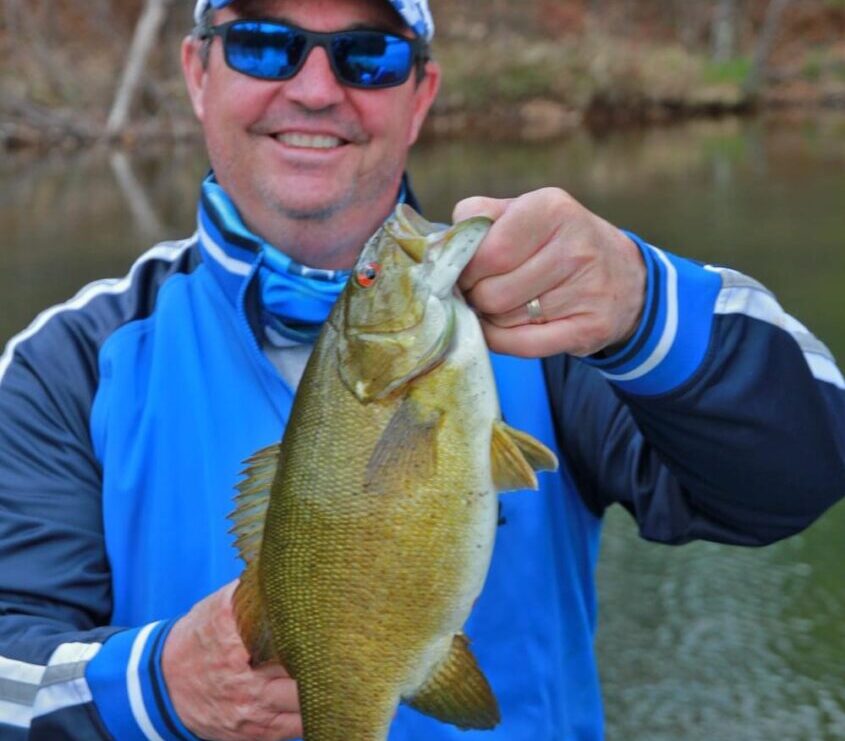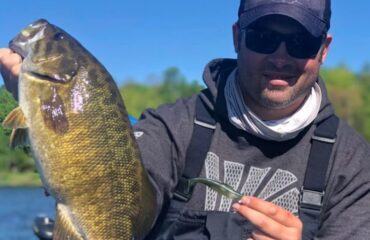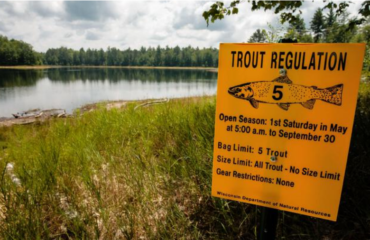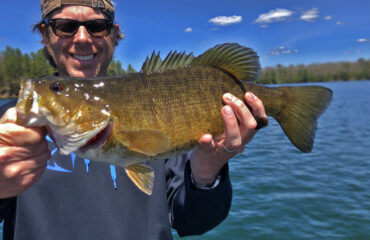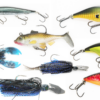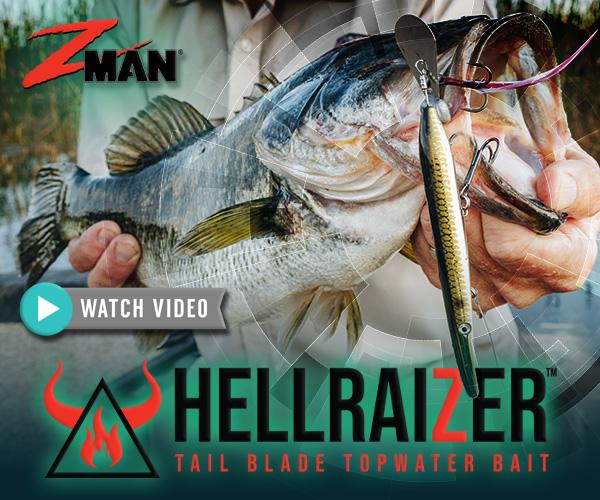Shallow Wood and Sand Patterns
The most active smallmouths will attract to lake regions that are warming. The shallows with ideal bottom substrate and exposure to sun warm rapidly. They could be up to 10 degrees warmer than anywhere else on the lake. Smallmouths can gather and loiter around in depths as shallow as 1 foot to as deep as 10 feet if that’s its edge. On some lakes, it’s common to encounter several dozen inactive large smallmouths sun-bathing in the extreme shallows, tucked up against wood for warmth and protection.
As sunlight hits specific pieces of structure and reflects off certain bottom types, the surrounding area will bake and warm rapidly. I generally reference these areas as “microwaves”. Every lake I fish for smallmouths is full of these unique spots and they are nothing more than natural heat conductors that can only be found on your own.
Sand pockets, isolated beaches, and shorelines with exposure to southern skies conduct heat. Smallmouth using these locations will proceed to lie on bottom, absorbing every ray. Additionally, laydowns and shoreline wood will attract fish as well. It’s remarkable to observe how smallmouths congregate and pin themselves to barren sand and shoreline wood that may in a foot of water just to absorb heat when nothing else is warming.
Hair Patterns
Slow horizontal presentations dominate in these shallows. The fluff of a marabou jig is dense, slowing its drop. These puff balls are unbeatable when fish are wary, finesse is required, and conditions are calm. 3/16, 1/8, 1/16, and 3/32-ounce hair jigs that achieve hang time and behave as a slow-falling glide bait will stay in the strike zone longest. Black is the most ideal color, but olives, browns, and purples catch fish too. The technique relies on long, light-powered rods and 5 lb. braided line with a monofilament leader.
The best quality hair jigs are hand-crafted by avid fly fishermen, anglers, and independent manufacturers. My favorites are tied by Gregg Kizewski, of 3G Smallmouth Solutions in St. Germain, WI.
Kizewski’s hair jigs are overdressed with pulsating marabou, benefitting the slow glide and hang time. If the jig doesn’t meet personal preferences, snip and remove excess hair to downsize the jig, and increase the fall rate.
Another winner in my boat is Jim DeZurik’s River Bug. The first time I saw my clients use this hair jig during a spring 2022 smallmouth trip, I was mind-blown. It out-fished every other hair jig I had in my boat, even Kizewski’s.
The River Bug is medium-density bucktail tied on a painted ballhead jig. It features two neck feathers, which is the jig’s greatest attribute. DeZurik says it creates a minnow profile, and the light tail feathers almost move by themselves when it’s on bottom. In the retrieve, both tail feathers collapse. And on the fall, the tail feathers open slowly. Smallmouths are dumbfounded by it.
With the proper tackle, allow the hair do all the work and slow glide for you. You need a long rod with a large capacity spool to get the fur-ball out there. I’ve previously favored 7 and a half foot medium light rods such as the Mojo Bass Hair Jig (MJS76MLXF), however St. Croix’s new introduction of the Legend Tournament Hair Jig (LBTS710MLXF) overtook it as being my favorite. It launches hair jigs a mile.

Grub Patterns
Across several lakes, smallmouths promptly arrive in the shallows, especially if they’re smaller and protected southern-exposed bays. If using Google earth or your navigational charts to study a lake and its topography, be hopeful of it featuring a shallow bay or two (includes coves or pockets) containing sand and muck with elements of rock and wood. If its placement is somewhere along the lake’s northern, eastern, or western shores, it’s likely to be warming at a rapid rate at some point in the day. When they do, smallmouths gravitate to these areas in high numbers.
The focus area should be the edges and entrances. This is where smallmouths are likely to settle and use first as staging sites. Under warming conditions, smallmouths will infiltrate into them further for feeding, resting, and their own sun bathing. Side imaging and 360-imaging will confirm their presence.
As waters are in the mid-40’s to the low-50’s, the best shallow bays and pockets can congregate dozens of smallmouths where fish could be milling around and chilling amongst one another. If they aren’t out in the open, I commonly find them holding up tight in the bay’s extreme shallows seeking further warmth.
Shallow bays can be of hard and soft bottom. Smallmouths will favor rock, boulder and wood habitat, with a bottom of sand and muck, and maybe gravel or rock in any combination at these locations. Some of the best shallow bays I’ve found encompass rock shoals, and even cabbage beds.
To target these fish, I swim slowly and subtly with swimming grubs.
Grubs mesmerize smallmouths everywhere. Whether smallmouths are active or inactive, a grub can always be relied on for catching a few fish, no matter the conditions.

Kalin’s 5-inch Lunker Grubs fished on exposed ¼ oz. minnow heads are my boat’s fish finders and fish catchers on most days. If downsizing is necessary, in which smallmouths are fixated on smaller prey, consider downsizing to a 3-inch Lunker Grub with 1/8-ounce head. With lighter line it usually seals the deal.
Grubs will imitate everything. On my clear natural lakes, I always strive to use natural baitfish profiles and translucent colors. My favorites from Kalin’s are Avocado, Apple Juice, Pumpkin, White Crystal, and Smoke.
Casting and steady retrieving them is the standby technique. Along the bay’s deepest edges, one can often get a nice flurry of bites along the first breaks in 5 to 10-foot depths. The same could also be replicated atop shallow flats when drifting and covering water. Make far casts, and run your swimmer thru the lower water column. Turning your reel 1x every second will maintain it at these depths. When smallmouths are shallower, downsizing your head to a 1/16-ounce or 1/8-ounce ball or minnow shaped head will allow you to probe through the skinnier water.



